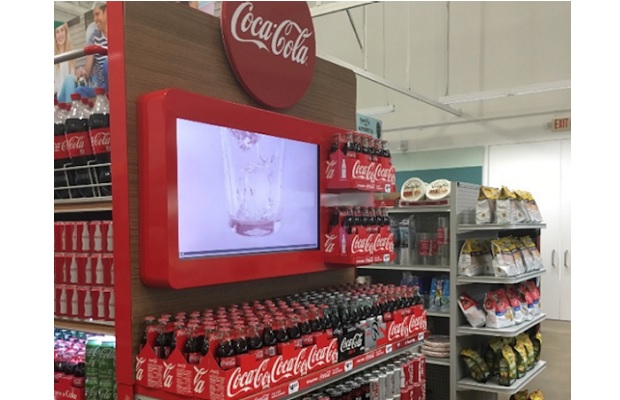Digital advertising solutions in-store are heading for a massive shake-up, as shopper marketing techniques start to apply web approaches to personalisation. Coca-Cola has launched in-store display systems that show personalised messages to approaching shoppers, based on data on their smartphones.
The system is powered by Google Cloud technologies and works on any HDMI-ready display that serves as grocery store aisle “end caps”, restaurant menu boards, and even interactive cinema posters.
The system can be used to offer custom branded video, e-coupons to shoppers. The technical solution uses DoubleClick’s ad-serving software to distribute targeted messaging, which opens up many of the approaches familiar to web marketers. The promotional content can range from brand campaigns to store-specific promotional offers, or even app-guided shopping lists, in a move that is widely expected to mark a step-change in the role of point of sale.
Integration with other retail systems lets the same approach deliver inventory and sales data, creating both messaging that is more valuable to the shopper, and data that is more valuable to the retailer.
Greg Chambers, global group director of digital innovation at Coca-Cola, said: “We kicked off a rapid iteration process in the spring of 2015 and had our first prototype that fall,” Chambers said during a presentation at the Google Cloud Next conference in San Francisco.
Proximity technology leverages built-in smartphone features and Google’s Eddystone wireless beacon technology, allowing a store to receive and interpret a nearby user’s preferences and habits to deliver contextually relevant content in real time.

“We can understand who the consumer is and get the right content and messaging to him or her at the right time,” Chambers said. “We’re using the power of the cloud to bring a real-time, media-rich experience to shoppers in the store.”
A 250-store pilot with the Albertsons grocery chain delivered a one-month return on investment. “We also significantly increased category lift,” Chambers said, “which means not only did the end-caps help sell more Coca-Cola products… everything else on the carbonated soft drink aisle, too.”
Given the scale of Google’s marketing clout and technology development, this should be treated as a play for the final step in the shopper’s journey. “In-store marketing is finally ready for the digital revolution”, explains Danny Meadows-Klue, Chief Executive of Digital Strategy Consulting. “On the laptop and small screen, the digital marketing industry has 20 years of experience in creating, delivering and refining strong consumer experiences. Most of the shopper’s journey to purchase has already been widely researched, cookied and optimized – but in-store has remained the elusive, yet critical step. That’s now ready to change. Google wants its adserving to be the platform for offline retail, and it’s starting here.”

